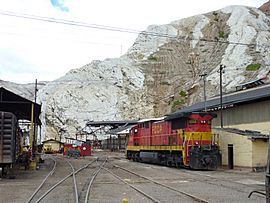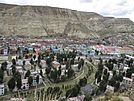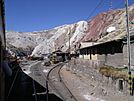La Oroya facts for kids
Quick facts for kids
La Oroya
San Jerónimo de la Oroya
|
|
|---|---|
|
Town
|
|
|
View of some rail stations and the city
|
|
| Country | |
| Region | Junín |
| Province | Yauli |
| District | La Oroya |
| Area | |
| • Total | 388.42 km2 (149.97 sq mi) |
| Elevation | 3,745 m (12,287 ft) |
| Population | |
| • Estimate
(2015)
|
24,476 |
| Time zone | UTC-5 (PET) |
| Website | www.oroya.com.pe |
La Oroya is a city in central Peru, located on the Mantaro River. It is the capital of the Yauli Province in the Department of Junín. The city sits high in the Andes mountains at an altitude of 3,745 meters (about 12,287 feet). It is about 176 kilometers (109 miles) east-north-east of Lima, Peru's capital city.
La Oroya is known for its large metal processing plant, called a smelter. This smelter was once listed as one of "The World's Worst Polluted Places" in a 2007 report. The city is also the end point of the Central Highway of Peru, an important road.
Contents
History of La Oroya
Early Settlement and Independence
In 1533, the Spanish started a small settlement in the area. They began mining for valuable metals like gold and silver. However, it was hard to get the metals out due to the remote location and transport issues.
During the Peruvian War of Independence, La Oroya's location made it a key spot for freedom fighters. A major battle, Chacamarca (Junín), happened nearby. After this battle, Simón Bolívar, a famous leader, passed through the town.
In 1861, the settlement was named San Jeronímo de Callapampa. It became La Oroya in 1893. Later, in 1925, La Oroya was made the capital of the Yauli province. Finally, in 1942, it officially became a city.
Developing Mining and Railways
Mining in the area grew slowly at first. It really took off after the Ferrocarril Central Andino railway from Lima was finished in 1893. This railway was an amazing engineering achievement. It was designed by Polish railway builder Ernest Malinowski.
The railway crosses the Ticlio Pass, reaching a height of 4,781 meters (15,686 feet). For a long time, it was the highest standard gauge railway in the world. It held this record until the Qinghai-Tibet Railway was completed more recently.
The Smelter's Journey
The smelter, which is now the city's main employer, was built in 1922. It was first run by an American company called Cerro de Pasco Corporation. In 1974, the Peruvian government took over the company. It became part of a state-owned company called Centromin.
In 1993, the Peruvian government decided to sell Centromin to private companies. In 1997, a company called Doe Run Peru bought most of the La Oroya smelter. They paid about US$247 million for it. Doe Run Peru also bought a copper mine to ensure they had enough materials for the smelter.
Economy and Metal Production
How Metals are Made
The La Oroya smelter started with a copper plant in 1922. A lead plant was added in 1928, and a zinc plant in 1952. These plants can produce many tons of copper, lead, and zinc each year. However, they often produce less to help control air pollution.
Local mines produce "dirty concentrates." These are metal ores that contain other metals mixed in. Over the years, experts at La Oroya have found ways to separate and recover these extra metals. This makes the smelter very special.
La Oroya is one of the few places in the world that can do this. It produces valuable metals like gold and silver. It also makes other metals such as antimony, bismuth, cadmium, and indium. The plant also produces sulfuric acid. This special technology helps reduce harmful emissions.
Challenges with Pollution
When Doe Run bought the smelter, it was old and needed repairs. Previous owners had not invested much in modernizing it or making it cleaner. Because of many years of pollution, the hills around the smelter lost all their trees. The river also became more polluted.
The health of people living in the area was affected. Many residents were found to have high levels of lead in their blood and drinking water. They also had breathing problems. A study in 1999 showed very high levels of air pollution. It found much more arsenic, cadmium, and lead than what is considered safe.
Efforts to Reduce Pollution
Environmental Cleanup Plans
When Doe Run bought the smelter, they agreed to an environmental plan called PAMA. This plan required them to take steps to clean up the environment. These steps included building new sulfuric acid plants and cleaning up wastewater. They also had to manage waste from the smelter and improve air quality.
Doe Run Peru was protected by the Peruvian Government from environmental problems caused by previous owners. Doe Run's original plan was to spend US$107 million on PAMA. However, the cost was expected to be at least US$244 million.
Extensions and Progress
In 2004, Doe Run asked for more time to complete the PAMA plan. The Peruvian Government agreed to an extension in 2006. This was due to reasons like money availability and extra cleanup needs. The company agreed to put money aside each month for the cleanup. They also promised not to pay shareholders if it would stop the cleanup work.
The PAMA plan was changed to include more goals. These goals included reducing air pollution and protecting public health. Special health programs were set up for children and pregnant mothers. The aim was to reduce lead levels in their blood.
In 2008, Doe Run Peru reported good news. Health officials confirmed that the smelter's liquid waste no longer polluted the Yauli or Mantaro Rivers. However, the company noted that other mining operations upstream still polluted the river.
By March 2008, the company announced big improvements. They reported a 60% drop in tiny particles in the air. Lead levels in the air dropped by 61.7%, and cadmium levels by 72%. Arsenic levels decreased by 81%. They also said they had almost stopped polluting the rivers with liquid waste.
Ongoing Challenges
Despite these improvements, sulfur dioxide pollution reached high levels in August 2008. However, a new plant for the lead smelter started working in October 2008. This was expected to greatly reduce sulfur dioxide emissions. More improvements were expected when the copper smelter plant was finished.
However, some of these expected results have not been fully achieved. The improvements reported by Doe Run were not officially confirmed by independent groups. Even with high earnings, Doe Run asked the Peruvian Government for financial help. This request came with another request for more time to meet the PAMA requirements. This meant the expected cleanup goals for 2009 were not met.
Community Action
The people of La Oroya have received legal help for over twenty years. This support comes from the Interamerican Association for Environmental Defense (AIDA). A lawyer named Astrid Puentes Riaño led this work. In 2024, the United Nations chose her for an important role. She became a United Nations special rapporteur focused on human rights and the environment.
Climate in La Oroya
| Climate data for La Oroya, elevation 3,842 m (12,605 ft), (1991–2020) | |||||||||||||
|---|---|---|---|---|---|---|---|---|---|---|---|---|---|
| Month | Jan | Feb | Mar | Apr | May | Jun | Jul | Aug | Sep | Oct | Nov | Dec | Year |
| Mean daily maximum °C (°F) | 15.4 (59.7) |
15.1 (59.2) |
15.0 (59.0) |
15.5 (59.9) |
16.0 (60.8) |
15.6 (60.1) |
15.3 (59.5) |
15.7 (60.3) |
15.8 (60.4) |
16.0 (60.8) |
16.8 (62.2) |
15.5 (59.9) |
15.6 (60.2) |
| Mean daily minimum °C (°F) | 3.4 (38.1) |
4.1 (39.4) |
4.0 (39.2) |
2.7 (36.9) |
0.4 (32.7) |
−1.7 (28.9) |
−2.3 (27.9) |
−1.3 (29.7) |
0.9 (33.6) |
2.1 (35.8) |
2.3 (36.1) |
3.4 (38.1) |
1.5 (34.7) |
| Average precipitation mm (inches) | 93.2 (3.67) |
102.8 (4.05) |
81.2 (3.20) |
46.6 (1.83) |
22.3 (0.88) |
13.5 (0.53) |
13.3 (0.52) |
17.4 (0.69) |
37.3 (1.47) |
52.0 (2.05) |
57.0 (2.24) |
91.0 (3.58) |
627.6 (24.71) |
| Source: National Meteorology and Hydrology Service of Peru | |||||||||||||
See also
 In Spanish: La Oroya para niños
In Spanish: La Oroya para niños








